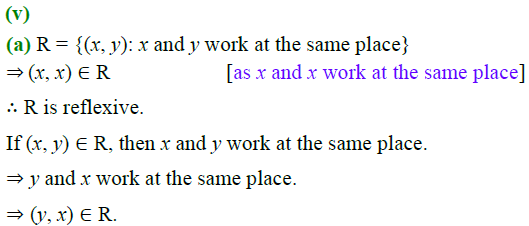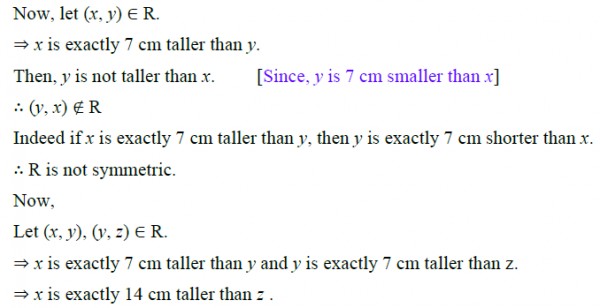

∴ R is not transitive.
Hence, R is neither reflexive, nor symmetric, nor transitive.
(iii) A = {1, 2, 3, 4, 5, 6}
R = {(x, y): y is divisible by x}
We know that any number (x) is divisible by itself.


∴ R is symmetric.
Now,
Let (x, y) and (y, z) ∈ R, where x, y, z ∈ Z.
⇒ (x − y) and (y − z) are integers.
⇒ x − z = (x − y) + (y − z) is an integer.
∴ (x, z) ∈ R
∴ R is transitive.
Hence, R is reflexive, symmetric, and transitive.

∴ R is symmetric.
Now, let (x, y), (y, z) ∈ R
⇒ x and y work at the same place and y and z work at the same place.
⇒ x and z work at the same place.
⇒ (x, z) ∈ R
∴ R is transitive.
Hence, R is reflexive, symmetric and transitive.
(b) R = {(x, y): x and y live in the same locality}
Clearly, (x, x) ∈ R as x and x is the same human being.
∴ R is reflexive.
If (x, y) ∈ R, then x and y live in the same locality.
⇒ y and x live in the same locality.
⇒ (y, x) ∈ R
∴ R is symmetric.
Now, let (x, y) ∈ R and (y, z) ∈ R.
⇒ x and y live in the same locality and y and z live in the same locality.


∴ (x, z) ∉ R
∴ R is not transitive.
Hence, R is neither reflexive, nor symmetric, nor transitive.
(d) R = {(x, y): x is the wife of y}
Now,
(x, x) ∉ R
Since x cannot be the wife of herself.


(e) R = {(x, y): x is the father of y}
(x, x) ∉ R
As x cannot be the father of himself.
∴ R is not reflexive.
Now, let (x, y) ∉ R.
⇒ x is the father of y.
⇒ y cannot be the father of y.
Indeed, y is the son or the daughter of y.
∴ (y, x) ∉ R
∴ R is not symmetric.
Now, let (x, y) ∈ R and (y, z) ∉ R.
⇒ x is the father of y and y is the father of z.
⇒ x is not the father of z.
Indeed x is the grandfather of z.
∴ (x, z) ∉ R
∴ R is not transitive.
Hence, R is neither reflexive, nor symmetric, nor transitive.